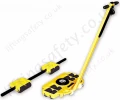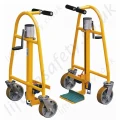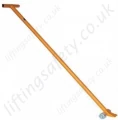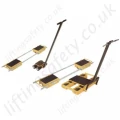-
Lifting Equipment

Lifting Equipment
- Chain Hoists
-
Wire Rope Hoists & Winches
- Hand Operated Wire Rope Winches and Hoists
- Cable Pullers / Hoists, Wire Rope Manual Operation
- Electric Winches and Hoists, AC (Mains Powered)
- Scaffold Hoists & Accessories
- Overhead Wire Rope Crane Hoists
- Hydraulic Wire Rope Winches & Hoists
- Pneumatic Wire Rope Air Winches / Hoists (Lifting and Pulling)
- Vehicle Mounted Winches
- Tractel Wire Rope & Accessories
-
General Lifting Equipment
- Lifting Slings and Components
- Lifting Shackles
- Eye Bolts and Nuts
- Weld-on Lifting Eyes and Lashing Points
- Lifting & Pulling Clamps
- Lifting Beams & Spreader Beams
- Precast Concrete Lifting
- Lifting Magnets, Permanent, Battery Electric and Manual
- Runway Beam Monorail Crane Trolleys, Push, Geared & Electric
- Equipment Identification Tags
-
Rigging Equipment
- Master Ring & Load Suspension Eyes
- Lifting & Rigging Hooks
- Turnbuckles & Rigging Screws
- Wire Rope Accessories and Fittings
- Snatch Blocks, Sheave Blocks and Crane Pulley Blocks
- Pulley Sheaves
- Lifting & Rigging Swivels - Eye, Hook & Shackle
- Load Restraint Equipment
- General Rigging Accessories
- Crosby Lifting & Rigging
-
Cranes & Gantry Systems
- Portable Davit Arms and Jib Cranes
- Swing Jib Cranes - Installed Floor & Wall Cranes
- Portable/Mobile Free-standing Swing Jib Cranes
- Aluminium Gantry Cranes
- Steel Gantry Cranes
- Fixed Steel Gantry Systems
- Shearlegs, Tripods & Quadpods
- Overhead Crane Systems
- Portable Shop-Floor/Workshop/Garage Cranes
- Counterbalance Floor, Workshop Cranes
- Scaffolding Runway Beam Systems
-
Material Handling & Jacking Equipment
- Machinery & Load Moving Skates
- Hydraulic Cylinders & Pumps
- Lifting Jacks
- Manhole Cover Lifters
- Hydraulic Pull Cylinders
- Hand Operated Pallet Trucks, Pump Trucks
- Stacker Trucks, Materials Lifts, Manual and Electric
- Genie and Counterbalance Materials Lifters
- Scissor Lift Tables
- Drum Handling Equipment
- Crane Forks
- Load Weighing Equipment - Load Cells
- Tool Spring Balancers / Load Balancers
- Platform Trucks & Trolleys
-
Forklift Truck Attachment
- Fork Mounted Man Riding Baskets
- Environment & Waste Handling Attachments
- Fork Lift Truck Mounted Drum Handling Attachments
- Fork Mounted Jib and Hook Attachments
- Fork Truck Booms & Tines
- Stainless Steel Forklift Attachments
- Forklift Truck Fork Extensions
- Multi Fork Attachments
- Fork Truck Scoop Attachments
- Big Bag Fork Truck Attachment
- Closed Base Coil Support Attachments
- Forklift Fork Protection Sleeves
- Snow Plough Fork Lift Truck Attachments
- Other Forklift Truck & Telehandler Attachments
- Specialist Lifting Equipment
- Access and Safety Related
- Workshop and Shop Floor
- Screwjacks & Actuators
-
Height Safety

Height Safety Equipment
-
Fall Arrest and Height Safety Harnesses
- General Use Harnesses EN361
- Work Positioning Harnesses EN361 & EN358
- Rope Access Harnesses
- Rescue Harnesses EN1497 & EN361
- Ladies & Childrens Harnesses
- Hi Vis Jacket/Vest Harnesses
- Welders Harnesses
- ATEX (Anti-Static) Harnesses
- Linesman Harnesses
- Oil Derrick Harnesses
- Sport Climbing Harnesses
- Tree Surgeon Positioning Harnesses
- Sit and Chest Harnesses. EN361 EN356 & EN831
- Work Positioning & Restraint Belts EN358
- Fall Arrest, Restraint and Positioning Lanyards
- Height Safety and Fall Arrest Kits
- Inertia Reels and Retrieval Blocks
- Man-riding Hoists & Rescue Winches
-
Fall Arrest & Man-riding Systems
- Fall Arrest Davit Arms & Posts for Working at Height
- Sala Advanced Davit Arm Systems and Components
- Xtirpa Confined Space Davit Arm Systems and Components
- Abtech Man-riding, Fall Arrest and Rescue Davits and Components
- Man-riding & Rescue Tripods & Quadpods
- Manriding Systems, Baskets and Chairs
- Mobile Fall Arrest Gantries, Systems & Steps
- Rope Guided Fall Arresters (Steel & Synthetic Rope)
- Temporary Horizontal Fall Arrest Lifelines
- Vertical Fall Arrest Systems Permanently Installed
- Horizontal Fall Arrest Systems Permanently Installed
- Manriding Baskets Fork Truck and Overhead Crane
- Tank Side Entry and Vehicle Fall Arrest Systems
- Suspension Seats / Bosuns Chair Working at Height
- Collective Fall Arrest Systems
- Man-Riding Sheave Blocks
- Anchorage Devices
- Karabiners & Connectors
- Rescue, Evacuation & Rope Access
-
General Height Safety Gear
- Height Safety Accessories
- Industrial & Climbing Height Safety Helmets
- Synthetic Height Safety Rope & Anchorage Lines
- Height safety Pulley Wheels For Synthetic & Steel Wire Rope
- Black Height Safety Equipment & PPE
- Hot Work Equipment. Cutting, Grinding & Welding
- Cases, Bags, Backpacks, Holdalls. Height Safety Gear
- Telescopic Extension Pole for Height Safety Applications
- Wind Energy Height Safety Equipment
- Stainless Steel Fall Arrest Equipment
-
Fall Arrest and Height Safety Harnesses
- Home
- About Us
-
Contact
Get In Touch
- Home/
- Lifting Equipment/
- Material Handling & Jacking Equipment/
- Machinery Moving Skates, Materials Skates & Load Moving Skates/
- Caterpillar Load Moving Skates Steel rollers/
- Yale (Steerman) SCS Caterpillar Load Moving Skates - Range from 20,000kg to 60,000kg
Yale (Steerman) SCS Caterpillar Load Moving Skates - Range from 20,000kg to 60,000kg
Yale Steerman tank track type load moving machinery skates.
Yale SCS / CS-258

20 tonnes, 30 tonne and 60 tonnes options available
Steerman Caterpillar Skates provide an economic and robust solution to many load moving and placement problems.
Steerman SCS-20, SCS-30 and SCS-60 Caterpillar Skates are designed for the movement of heavy loads over flat even surfaces. With capacities of 20t, 30t, and 60t it is the operator’s responsibility to decide the correct capacity for each specific application. Whenever possible it is advisable to run the units over a flat steel-plated surface, channel sections or rails. The harder the operating surface the less rolling resistance is encountered making the load easier to move.
Extract from operating instructions
- Check that the rollers are free from any embedded debris before using the system.
- Use on smooth level surfaces - plated steel floors are recommended. The load must always be evenly distributed on the system.
- Use some form of anti-slip mat or wooden board between the skate surfaces and the load.
- Keep hands and feet well clear of all areas beneath the load being raised, lowered or carried.
- Operate the equipment within its capacity. DO NOT OVERLOAD.
- Keep fingers clear of the skate rollers when lifting the system. The rollers are designed to rotate.
- Avoid shock loading when positioning or carrying industrial loads.
- Use appropriately rated jacks to lift and lower loads onto the Steerman Caterpillar Skate System rather than lowering directly from a crane or fork lift truck.
- Ensure that the rear skates are kept parallel to the load and the line of direction by means of the alignment bar supplied.
- Don’t operate the equipment over rough uneven surfaces, floor joints, sliding door tracks, manhole covers, tarmac or asphalt or on uneven or inclined surfaces.
- Do not operate the equipment until you have ascertained that the weight and centre of gravity of the load being carried is in the centre of the 3-point loading system, and do not operate the equipment until you have ensured that the load is balanced, stable and that all personnel are standing clear of the load and the intended route of travel.
Features include:
- Carrying capacity of 20t, 30t or 60 tonnes.
- Professional build quality.
- Modular concept allows linking of units.
- Robust lockable steel container with nylon castors.
| Model | Capacity | Weight (kg) |
| SCS-20 | 20 tonnes | 50 |
| SCS-30 | 30 tonnes | 58 |
| SCS-60 | 60 tonnes | 92 |
Operating Instructions
| Always... | Do Not... |
|
|
Getting Started:
- Ensure that you have selected a set of Steerman Caterpillar skates that are designed to carry the full weight of your intended load.
- Ensure that you have all the necessary lifting jacks, restraining equipment and pulling or pushing devices needed for the job.
- Assess the shape of the load to determine the best position for the skates. REMEMBER the load must rest evenly on the three or four point skate pads, with the weight evenly distributed over all three or four points.
- Always raise the rear part of the load first, using appropriately rated hydraulic claw jacks, then place the two rear trolleys in position. Ensure that some form of anti-slip mats or wooden boards are in place between the load and the tops of the trolleys. The alignment bar should be positioned perpendicular to the direction of the travel to avoid “crabbing” when the load is moved. Carefully lower the load onto the rear trolleys and remove the jacks.
- Next, Jack up the front of the load using appropriately rated hydraulic claw jacks and position the front steering unit/s-fitted with a turntable under the load ensuring that all hands and fingers are not above the top surface of the trolley. Again ensure that the anti-slip mats or wooden boards are in place on the turntable pads.
- Lower the load onto the steerable front unit/s and double check that the load is evenly distributed and safely balanced.
- Check that the route to the final destination of the load is clear of debris and personnel and that the surface is suitable for both the weight of the load being carried and the system.
- Totally clear and clean the floor area and over the whole route to be travelled. Remove all grease, metal shavings, and any other forms of debris. REMEMBER, Steerman skates have only been designed to operate over smooth flat industrial floor surfaces.
Basic Techniques:
- The front skate/s must not be steered whilst the load is stationary. Steering can only really occur when the load is moving.
- When the system is moving, always position yourself so that you can effectively control the skates while at all times staying clear of the load.
- Extreme care should be taken to ensure that any operator, marshall or bystander does not get trapped between the load and any surrounding walls or obstructions.
- When pushing or pulling with a powered vehicle, secure a restraint cable or suitable sling to the load to prevent it running away.
- The operator should be within sight of any powered vehicle driver at all times. If this is not possible, a third person should be used to relay instructions between the operator and the driver.
- Whenever possible it is of great help to mark the floor to show the exact route the load will travel along and to mark where it is to be finally positioned.
- Check the path for debris before the operation and continually check in front and behind you as you steer to make sure there is no danger of tripping or falling.
- Do not allow the load system to travel at speed or abruptly change its direction of travel.
Pricing
20 tonnes, 30 tonne and 60 tonnes options available
Steerman Caterpillar Skates provide an economic and robust solution to many load moving and placement problems.
Steerman SCS-20, SCS-30 and SCS-60 Caterpillar Skates are designed for the movement of heavy loads over flat even surfaces. With capacities of 20t, 30t, and 60t it is the operator’s responsibility to decide the correct capacity for each specific application. Whenever possible it is advisable to run the units over a flat steel-plated surface, channel sections or rails. The harder the operating surface the less rolling resistance is encountered making the load easier to move.
Extract from operating instructions
- Check that the rollers are free from any embedded debris before using the system.
- Use on smooth level surfaces - plated steel floors are recommended. The load must always be evenly distributed on the system.
- Use some form of anti-slip mat or wooden board between the skate surfaces and the load.
- Keep hands and feet well clear of all areas beneath the load being raised, lowered or carried.
- Operate the equipment within its capacity. DO NOT OVERLOAD.
- Keep fingers clear of the skate rollers when lifting the system. The rollers are designed to rotate.
- Avoid shock loading when positioning or carrying industrial loads.
- Use appropriately rated jacks to lift and lower loads onto the Steerman Caterpillar Skate System rather than lowering directly from a crane or fork lift truck.
- Ensure that the rear skates are kept parallel to the load and the line of direction by means of the alignment bar supplied.
- Don’t operate the equipment over rough uneven surfaces, floor joints, sliding door tracks, manhole covers, tarmac or asphalt or on uneven or inclined surfaces.
- Do not operate the equipment until you have ascertained that the weight and centre of gravity of the load being carried is in the centre of the 3-point loading system, and do not operate the equipment until you have ensured that the load is balanced, stable and that all personnel are standing clear of the load and the intended route of travel.
Features include:
- Carrying capacity of 20t, 30t or 60 tonnes.
- Professional build quality.
- Modular concept allows linking of units.
- Robust lockable steel container with nylon castors.
| Model | Capacity | Weight (kg) |
| SCS-20 | 20 tonnes | 50 |
| SCS-30 | 30 tonnes | 58 |
| SCS-60 | 60 tonnes | 92 |
Operating Instructions
| Always... | Do Not... |
|
|
Getting Started:
- Ensure that you have selected a set of Steerman Caterpillar skates that are designed to carry the full weight of your intended load.
- Ensure that you have all the necessary lifting jacks, restraining equipment and pulling or pushing devices needed for the job.
- Assess the shape of the load to determine the best position for the skates. REMEMBER the load must rest evenly on the three or four point skate pads, with the weight evenly distributed over all three or four points.
- Always raise the rear part of the load first, using appropriately rated hydraulic claw jacks, then place the two rear trolleys in position. Ensure that some form of anti-slip mats or wooden boards are in place between the load and the tops of the trolleys. The alignment bar should be positioned perpendicular to the direction of the travel to avoid “crabbing” when the load is moved. Carefully lower the load onto the rear trolleys and remove the jacks.
- Next, Jack up the front of the load using appropriately rated hydraulic claw jacks and position the front steering unit/s-fitted with a turntable under the load ensuring that all hands and fingers are not above the top surface of the trolley. Again ensure that the anti-slip mats or wooden boards are in place on the turntable pads.
- Lower the load onto the steerable front unit/s and double check that the load is evenly distributed and safely balanced.
- Check that the route to the final destination of the load is clear of debris and personnel and that the surface is suitable for both the weight of the load being carried and the system.
- Totally clear and clean the floor area and over the whole route to be travelled. Remove all grease, metal shavings, and any other forms of debris. REMEMBER, Steerman skates have only been designed to operate over smooth flat industrial floor surfaces.
Basic Techniques:
- The front skate/s must not be steered whilst the load is stationary. Steering can only really occur when the load is moving.
- When the system is moving, always position yourself so that you can effectively control the skates while at all times staying clear of the load.
- Extreme care should be taken to ensure that any operator, marshall or bystander does not get trapped between the load and any surrounding walls or obstructions.
- When pushing or pulling with a powered vehicle, secure a restraint cable or suitable sling to the load to prevent it running away.
- The operator should be within sight of any powered vehicle driver at all times. If this is not possible, a third person should be used to relay instructions between the operator and the driver.
- Whenever possible it is of great help to mark the floor to show the exact route the load will travel along and to mark where it is to be finally positioned.
- Check the path for debris before the operation and continually check in front and behind you as you steer to make sure there is no danger of tripping or falling.
- Do not allow the load system to travel at speed or abruptly change its direction of travel.
Products of Possible Interest






Contact Us About This Product
If you wish to receive a quote for this product, please use the tab above, this form is for general enquiries regarding this product only.
You can also Request a Quote using the Quote tab above!
You can easily add more than one item to the Quote Request. This is highly recommended as we will be able to suit your needs much more efficiently.
